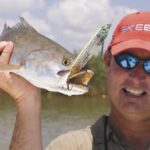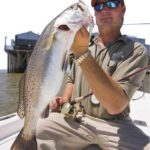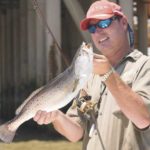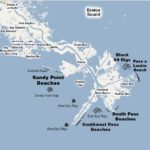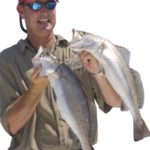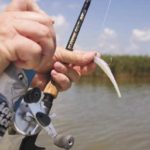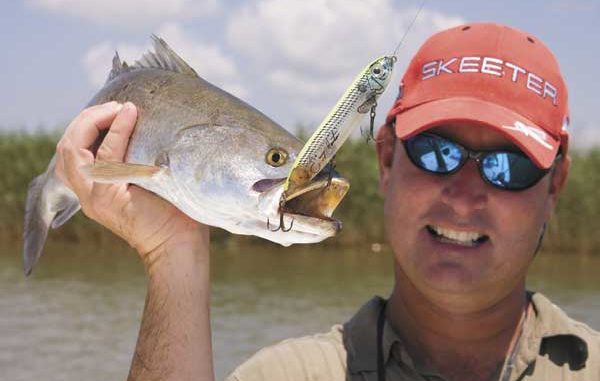
Go deep to catch the really big trout around the mouth of the river this month.
When Chris Paul pulls up from beyond the three-point line to drain a shot, his effort is rewarded with one more point than he would have made had his feet been in front of the line.
His shot and the ball going through the basket was the same as if he were inside the key. However, this same effort gets rewarded with a greater gain because he’s 3 inches outside the line.Other than the occasional three-point shot and last-second desperation heave, most of the action in a basketball game happens within the confines of that magic line.
Those players who are willing to play beyond the line can help their teams run up insurmountable leads as the other teams are making lay-ups. Three-point shooters can rack up points in a hurry.
The same could be said for fishing out of Venice during August. With Venice Marina being the basket, anglers frequently remain within the comfortable confines of the three-point line. What they don’t know is that for every two fish they catch close to the basket, there are other anglers fishing outside the line that are catching three.
Just where is the three-point line at Venice? Some anglers say it has to be the perimeter beaches that are the transition between the exterior marshes and the Gulf of Mexico. Fish right at that line, and your August catch will increase dramatically. Go even farther to the rigs behind the line, and your catch will get a lot heavier.
Fishing behind the line doesn’t come without certain risks. You could break down far from the ramp. You could get caught in a storm. You could get lost without the modern convenience of a GPS.
However, the rewards are great for those willing to take the risks.
Capt. Brent Roy operates Venice Charters Unlimited out of Venice, and he is one of the anglers who doesn’t mind fishing behind the line during August. He first pulls up to the beaches to see if he can score some quick fish.
“You could go on out and fish the rigs first thing in the morning because the fish are there,” Roy said, “but if you’re looking to catch a lot of fish, you’re better off stopping on the beaches early in the morning on your way out to the rigs.”
Stopping on the beaches could mean many different things to many different people based on where they’re fishing and what they call a beach. The beaches below Venice literally run from one side of the delta to the other.
Beginning on the east side of the river, Roy pointed out a spot like the beach at the end of Pass a Loutre might be a good starting point. From there, several good beaches can be found at the mouths of South Pass and Southwest Pass. Moving back north and toward Grand Isle, places like Sandy Point, Scofield and Four Bayou hold lots of fish.
“That’s a lot of area with good beaches,” said Roy’s fellow Venice guide Capt. Larry Averitt with L.A. Charters. “These spots are so spread out that you just about have to target one area for the entire day. Just about all these beaches are holding fish now, so the key is to pick an area based on what the wind and weather are doing.
“You make an educated guess in the morning, then try to home in on the trout by figuring out which spots along the beaches in the area you pick are holding bait.”
One of the things other than bait that make the beaches so productive in August is that they typically load up with male trout that are on them for spawning activity. Averitt said it’s not uncommon to catch several of the males, which are easily identified by their croaking sounds used to attract females.
What some anglers may not realize is that there is still a lot of cane stubble along some of the beaches from patches that simply eroded away or were beaten back by Hurricane Katrina. The stubble is still there under the water in many places that the trout get over to spawn.
“Starting about the middle of July, I fish exclusively from Scofield Bayou to Four Bayou Pass,” Roy said. “I typically go to Four Bayou first and work my way back to Scofield. During July and August, I feel like the west side of the river gives up bigger trout.
“And there is bait all over the beaches on that side right now. When you pull up to a spot and there are finger mullet, glass minnows and shrimp blowing everywhere out of the water, I guess you could say that would be a good spot.”
Roy and Averitt share similar ideas about how to best fish the beaches beginning at daybreak. Both begin by quickly scouring the surface with topwater lures like bone/chartreuse Super Spooks and silver/chartreuse She Dogs. The only difference between the two, based on Roy’s experience, is the She Dog tends to produce larger fish.
When their topwater bite dies, both guides pull out the plastics and begin fishing the troughs with a tightline presentation and the flatter areas with popping corks. While there are many modern pieces of plastic in nearly every conceivable color combination, there are few that have produced as many trout beyond the three-point line than one of the old reliables.
“I let the trout tell me what they want,” Averitt said, “but more often than not the old stand-by chartreuse sparkle beetle on a 1/4-ounce jighead fished 24 inches under a cork quickly loads the boat. That (combination) is still the top producer in Venice, and it’s probably caught more fish than any other bait ever made.”
Although the chartreuse beetle accounts for lots of fish during the summer months, neither angler minds setting it down in favor of live bait. The fish will tell you soon enough if they don’t want the plastics. If that’s the case, hang a live shrimp under the cork.
“One thing you’ve got to remember about fishing the beaches is that all of them aren’t going to look like the beaches found at Grand Isle or Fourchon,” said Roy. “Some of the beach stuff we fish isn’t really as much a beach as it is the cane shoreline, which is essentially the last bank before opening out to a big bay of the Gulf.
“The difference between a place like Venice and Fourchon is that Fourchon doesn’t have an exterior marsh like we have here. Even though some of these exterior banks may not look like a beach, if the beaches are holding fish, these kinds of banks are holding fish.”
After their spots just at the line dry as the sun continues to rise, Roy and Averitt turn their attention even farther beyond the line. This isn’t like the desperation half-court shot right at the buzzer, though. Rather, it’s how both guides keep the game alive. Call it the half-court shot that ties the game and sends it to overtime.
“If you are on a good bite at the beach, stay with it,” Averitt advised. “But if you get out there and catch 15 or 20, and they shut off, pull up and go to the deeper rigs. That’s where most of the bigger females go after they spawn — they move to the rigs, and they don’t feed very much.”
The good thing about the beach/rig combination is that no matter which beach you fish, there are productive rigs close by. Take the beach at the end of Pass a Loutre, for example. If you’re fishing there, and the bite dies, head on up to the Block 69 rigs just out from Raphael Pass.
“Block 69 tends to dwindle a little bit just after the Grand Isle Tarpon Rodeo,” Roy said. “But whether you fish the east side or the west side, there are some rigs close by that you can go fish. On the west side, you’ve got the West Bay rigs, the Sandy Point rigs, and even on over to a few out from Grand Isle.”
Roy looks for rigs that are in water ranging from 12 to 30 feet with his most productive depth being 17 to 22 feet. And he finds that the trout could be anywhere from just under the surface to right on the bottom.
Without a doubt, Roy’s best technique on the rigs is to drop a live Carolina-rigged croaker straight to the bottom. And in a move similar to snapper fishing, he cranks the reel a couple turns to bring his bait up about 3 feet.
“You just hold it there until they bite,” he said. “Their position can vary greatly, though, so sometimes I go with the only thing that works better than the vertical Carolina-rigged croaker — a croaker under a slip cork. A slip cork allows you to get your croaker in to some places you couldn’t otherwise. You can let the wind drift it up under the rig. That’s a great way to catch a really big trout.”
If he’s not letting his slip cork slide under the rig, Roy sets all the corks in his boat to different depths to help him quickly determine at what depth the fish are holding. He rigs them anywhere from 5 feet under the surface all the way to the bottom.
“You would be surprised, but sometimes that 5-foot depth is the best one even in the deep water,” he said. “And when there up like that, don’t hesitate to try a topwater. I’ve caught big trout off the Xylophone rig at 12 noon on a She Dog in 17 feet of water. Every day’s a little different, though, so you just have to figure them out each day. However, they do tend to be closer to the surface during cloudy days and deeper on sunny days.”
When Averitt first approaches a rig, he begins casting a 3/8-ounce jig with a soft plastic, which he counts down to 4 or 5 feet to see if they are suspended. From there, he goes with either a shrimp or croaker fished on the bottom with a Carolina rig.
“Actually, this year the cocaho minnows have been working well on the east side,” he said, “which is unusual because we’ve never had much success with them over here. Whatever I use, if I have four anglers in the boat, we fish 360 degrees around the boat to learn where the fish are positioned. This covers near the rig and away from the rig. Once we figure it out, we’ll all fish the same spot.”
While he knows just how productive fishing right next to a rig with a Carolina-rigged croaker just off the bottom can be, Averitt recommended anglers really explore what else is around the rig. It’s not unusual to catch fish 25, 50 or even 100 yards off the visible structure.
“When you get out that far, you may think you’re not fishing the rig anymore,” he said. “But some of these rigs have pilings that angle out rather than go straight up and down. So you may be catching fish 50 yards off the rig, but they are fish that are hanging out around one of those angling legs.”
With so many rigs to explore in any of the blocks around the mouth of the Mississippi, it can be difficult to determine which rigs hold fish. Even the best guides find them on one rig one day and a different one the next, so it pays to fish around a little bit. Also, anglers can look for rigs that have jack-up boats attached because those boats have to have a hard shell bottom to support the pilings.
“Be prepared to lose a lot of tackle when you’re fishing the rigs,” Averitt said. “There is a lot of debris on the bottom around all of them, and while they can be extremely productive, they can also be extremely frustrating to fish when you start breaking off every other cast. Don’t get out there without enough gear to support you for the day.”
Although many may be looking for the trout to begin making a run back to the interior marshes and even the river when it clears up, that’s not going to happen any time soon, according to Roy and Averitt.
“The beaches and rigs have the best salt content right now,” said Roy. “All the fresh water coming out of the passes, it’s pushing any fish that had already move in back out to the beaches and close rigs.”
So until the river gets right and the water turns green, go beyond your comfort zone this month and step behind the line. It might seem like a long shot, but once you get comfortable out there, you’ll be able to run up the score with the best of them.
Contact Capt. Brent Roy at www.venicecharters.com or 225-268-8420 and Capt. Larry Averitt at 225-761-9954 or 225-268-9616.
